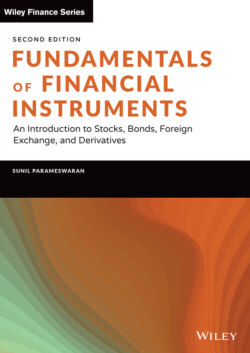Читать книгу Fundamentals of Financial Instruments - Sunil K. Parameswaran - Страница 47
На сайте Литреса книга снята с продажи.
DIRECT AND INDIRECT MARKETS
ОглавлениеIn a direct market, the surplus budget units in the economy deal directly with the deficit budget units. That is, funds flow directly from the ultimate lenders to the ultimate borrowers. For instance, if 3M were to be making a public issue of shares and an investor were to purchase them, then it would be termed as a direct market transaction. Similarly, if the government were to issue bonds to individual as well as institutional investors, it too would constitute a direct market transaction. In practice, an issuer of equity shares or debt securities can do so either through a public issue or through a private placement. A public issue entails the sale of the issue to a large and diverse body of investors, both retail and institutional. Such issues are usually underwritten by an investment banker. In the case of private placements, which are more common for debt issues, the issuer will sell the entire issue directly to a single institution or a group of institutions.
In the case of indirect financing the ultimate lender does not interact with the ultimate borrower. There is a financial intermediary who in such markets comes in between the eventual borrower and the ultimate lender. The role of such an intermediary is, however, very different from that of a broker-dealer or an investment banker, who too are financial intermediaries albeit in a different sense.
A classic example of a financial intermediary in an indirect market is a commercial bank. Take the case of a bank like BNP Paribas. It raises deposits from individual and institutional investors. From the standpoint of the depositor, who is the surplus unit in this case, the bank is the corresponding deficit unit. The bank will issue its financial claims to the depositors for whom these claims will constitute an asset. A bank passbook, or computerized statement, or a certificate issued in lieu of a longer-term deposit, is a manifestation of such a claim. The rate of interest on such claims is the rate of return for the depositors. The risk for such depositors is that the bank could fail. If so, they may lose all or a part of their deposits. In the United States bank deposits up to $100,000 are insured by the Federal Deposit Insurance Corporation (FDIC).
After accumulating funds by way of deposits, the bank will then lend to corporate and noncorporate entities in need of funds. For such borrowers, the bank is the surplus budget unit, and for the bank they constitute the deficit units. The bank will hold claims issued by such borrowers in return for the funds lent to them and will be entitled to all cash flows emanating from them. Obviously, the bank is exposed to the risk that the borrowing entities could go bankrupt.
As can be seen, the link between the ultimate lenders and the ultimate borrowers is broken by a financial intermediary such as a bank in the case of indirect markets. The ultimate lenders, that is, the deposit holders at the bank, have no claim on the assets of the eventual borrowers, nor do they have a claim on the cash flows generated by such assets. It is the bank that has a claim on such assets and the corresponding cash flows. The depositors have a claim solely against the bank and are dependent on its performance in order to get the promised return on their savings. Besides commercial banks, other financial intermediaries in indirect markets include insurance companies, mutual funds, and pension funds.
